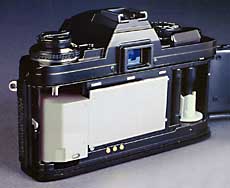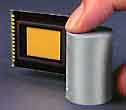EVERY 35mm CAMERA COULD BE
A DIGITAL CAMERA
Imagek chose the evening at the end
of the DIMA conference on February 11 to announce their new
Electronic Film System - the EFS-1 - to a hard-core group of no more
than twenty journalists. It's a concept often dreamed about - turning
any regular 35mm film stills camera into a digital camera simply by
inserting a digital 'film' cassette.
Imagek were only announcing the concept, not showing any
technology - they didn't even have a booth at PMA - though they did
distribute pictures of a scale mock-up of the device. They expect to
demonstrate a working model in spring 1998 and have the product in
the stores by summer for under $1,000.
 Well,
Seybold Seminars New York are held in spring, so we've invited Imagek
to show the EFS-1 for the first time at SSNY98. If the prototype is
ready, it will be shown in the special interest session, "You too can
be a Digital Photographer," on Thursday March 19 - or on Friday March
20 in "Great Tools for Perfect Images: Digital Photography, Scanning
and Imaging". The invitation has been extended and acknowledged but
don't blame us if it doesn't appear by then.
Well,
Seybold Seminars New York are held in spring, so we've invited Imagek
to show the EFS-1 for the first time at SSNY98. If the prototype is
ready, it will be shown in the special interest session, "You too can
be a Digital Photographer," on Thursday March 19 - or on Friday March
20 in "Great Tools for Perfect Images: Digital Photography, Scanning
and Imaging". The invitation has been extended and acknowledged but
don't blame us if it doesn't appear by then.
EFS-1 looks like a regular film cassette, with a rigid tongue of
'film' sticking out, which fits into the camera's film cavity.
Mounted on the rigid tongue is a 1.3 megapixel (1,280 x 1,024) CMOS
sensor which sits in the film plane. Inside the cassette is 40MB of
storage and a standard camera battery.
The unit is switched on by exposure to light - take one shot to
wake the device and a beep will tell you it's ready. Thirty pictures
can be taken, at a rate of one shot every two seconds, before the
storage is full. The unit automatically powers-down after
shooting.
To continue shooting when the device is full, the images must
first be downloaded and deleted, or you could just insert another
EFS-1 - just like inserting a new film. The far end of the tongue,
away from the cassette, has contacts which enable it to be slotted
into a Type 1 PCMCIA slot. This makes a PCMCIA card reader essential,
but no camera cables are required.
Imagek is the image capturing systems unit of Irvine Sensors
Corporation (NASDAQ: IRSN) (www.irvine-sensors.com), the inventors of
three dimensional semiconductors, with the noble aim of "improving
and expanding the world of digital photography". Imagek are at 3001
Redhill Avenue, Building 3, Costa Mesta, CA 92626-4529 telephone 800
851 1937. (www.imagek.com)
OUR PERSPECTIVE ON IMAGEK
Imagek are not the first to have had the dream of making 'digital
film'. The problems are huge. That's why we ain't seen nothin' -
yet.
 The
joint between the cassette and rigid tongue would be very prone to
damage and would have to be a masterpiece of engineering. The
delicate sensor would need shielding from dust and damage in a
photographers' bag or in the PCMCIA slot of a laptop. Imagine
dropping the EFS-1, even a short distance.
The
joint between the cassette and rigid tongue would be very prone to
damage and would have to be a masterpiece of engineering. The
delicate sensor would need shielding from dust and damage in a
photographers' bag or in the PCMCIA slot of a laptop. Imagine
dropping the EFS-1, even a short distance.
All the image processing would have to be done by software outside
the camera. The cassette would need DX coding, to relay the correct
ISO equivalence to the camera's exposure system. There will also be
camera-specific problems: for example, some bodies will not re-cock
the shutter unless a film is winding on. There would be a need for
separate viewfinder masking as the sensor area is smaller than the 24
x 36mm film area.
The advantages would be enormous, the ramifications far reaching.
No special camera bodies for digital - just use your existing
favorite. What would happen to the plethora of digital cameras now
appearing almost every week?
The announcement of the Imagek EFS-1 has been greeted with
incredulity. The buzz is going around the newsgroups with a great
deal of scepticism. "Something fishy," "It sure looks like a hoax"
and "Is it April 1st already?" are typical comments.
Let's reserve judgement until Seybold Seminars New York. It's a
neat concept, wouldn't it just be great if it worked?


This article first appeared as a Report for Seybold
Publications, February 1998.
IMPORTANT NOTICE
This document is Copyright © 1998 John Henshall. All rights
reserved.
This material may only be downloaded for personal non-commercial use.
Please safeguard the future of online publishing by respecting this
copyright and the rights of all other authors of material on the
Internet.


 Well,
Seybold Seminars New York are held in spring, so we've invited Imagek
to show the EFS-1 for the first time at SSNY98. If the prototype is
ready, it will be shown in the special interest session, "You too can
be a Digital Photographer," on Thursday March 19 - or on Friday March
20 in "Great Tools for Perfect Images: Digital Photography, Scanning
and Imaging". The invitation has been extended and acknowledged but
don't blame us if it doesn't appear by then.
Well,
Seybold Seminars New York are held in spring, so we've invited Imagek
to show the EFS-1 for the first time at SSNY98. If the prototype is
ready, it will be shown in the special interest session, "You too can
be a Digital Photographer," on Thursday March 19 - or on Friday March
20 in "Great Tools for Perfect Images: Digital Photography, Scanning
and Imaging". The invitation has been extended and acknowledged but
don't blame us if it doesn't appear by then. The
joint between the cassette and rigid tongue would be very prone to
damage and would have to be a masterpiece of engineering. The
delicate sensor would need shielding from dust and damage in a
photographers' bag or in the PCMCIA slot of a laptop. Imagine
dropping the EFS-1, even a short distance.
The
joint between the cassette and rigid tongue would be very prone to
damage and would have to be a masterpiece of engineering. The
delicate sensor would need shielding from dust and damage in a
photographers' bag or in the PCMCIA slot of a laptop. Imagine
dropping the EFS-1, even a short distance.